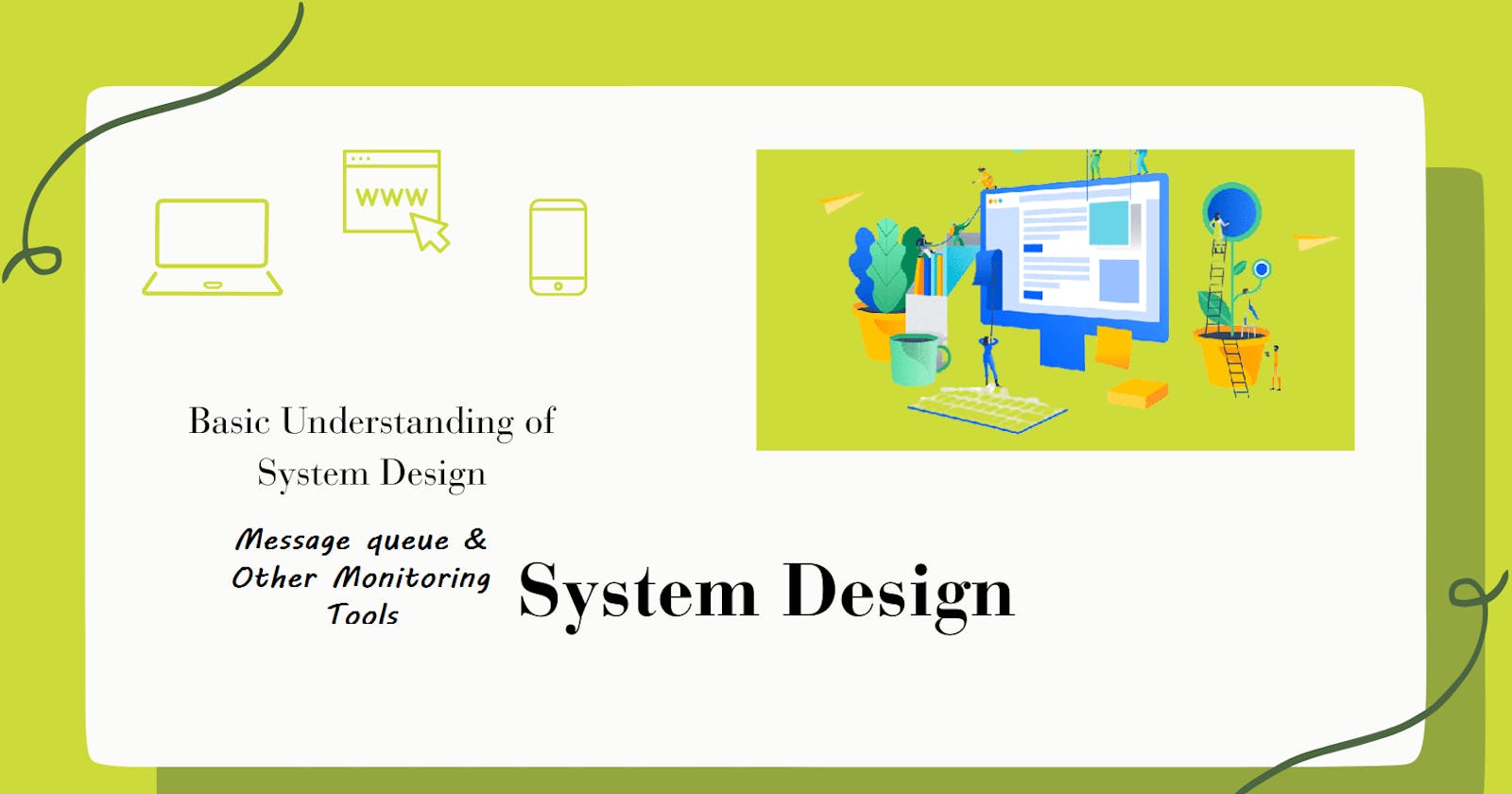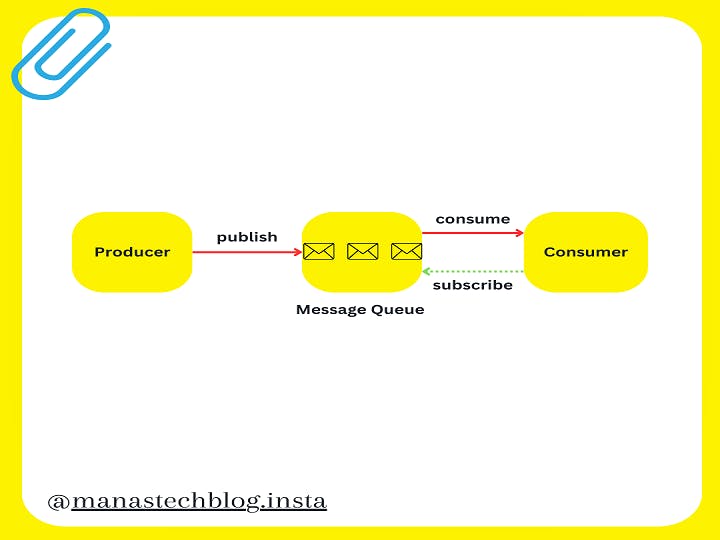System design refers to the process of conceptualizing and structuring a software system to address specific requirements. It involves identifying the system's components, their relationships, and interactions, and designing their interfaces. System design encompasses architectural decisions, data flow, communication protocols, algorithms, and storage considerations. The goal is to create a robust, scalable, and efficient system that meets functional and non-functional requirements such as performance, reliability, and security. It requires knowledge of software engineering principles, design patterns, and trade-offs. System design is crucial in building complex software applications that effectively solve real-world problems.
Understanding Message Queue
In system design, a message queue is a communication mechanism that allows different components or services within a system to exchange messages asynchronously. It provides a way to decouple the sender and receiver, allowing them to operate independently and at their own pace.
A message queue typically works as follows:
Components: In a system, there are multiple components or services that need to communicate with each other. These components can be distributed across different machines or run as separate processes on the same machine.
Producer: The component that generates a message and sends it to the message queue is called the producer. The producer encapsulates the message with any necessary data or metadata and sends it to the message queue.
Queue: The message queue acts as a buffer or intermediary between the producer and the consumer. It stores the messages in the order they were received.
Consumer: The component that receives and processes messages from the queue is called the consumer. Consumers can be one or many, depending on the system design. Each consumer reads messages from the queue independently and processes them according to its specific logic.
Asynchronous Communication: The communication between the producer and the consumer is asynchronous, meaning that the producer does not have to wait for the consumer to process the message. This decoupling allows both the producer and consumer to operate independently and at their own pace. The producer can continue generating and sending messages to the queue without being affected by the processing speed of the consumer.
Message Order: Message queues typically preserve the order of messages. Consumers read messages from the queue in the same order they were added. This order preservation ensures that the consumers process messages sequentially and in the desired sequence.
Message Durability: Depending on the type of message queue, messages can be stored persistently or in-memory. Persistently stored messages are durable and survive system failures, ensuring that no messages are lost. In-memory queues provide high-performance but may lose messages in the event of a failure.
Message queues are widely used in various system architectures and scenarios, such as microservices, event-driven architectures, and distributed systems. They enable loose coupling, scalability, fault tolerance, and efficient handling of high message volumes. Popular message queue implementations include Apache Kafka, RabbitMQ, and Amazon Simple Queue Service (SQS).
For Example:
Imagine a photo processing system that handles a high volume of image uploads and requires efficient processing. A message queue can be a valuable component in this scenario.
Producer: The photo upload service acts as the producer. Whenever a user uploads a photo, the service generates a message containing the image data and any necessary metadata.
Queue: The message queue receives and stores the photo upload messages in the order they are received. It acts as a buffer, ensuring the photos are processed sequentially.
Consumer: The photo processing service acts as the consumer. It continuously reads messages from the queue and processes them one by one. The processing can involve tasks such as resizing, applying filters, or generating thumbnails.
Asynchronous Processing: With the message queue, the photo upload service doesn't have to wait for the photo processing service to finish before accepting new uploads. It can quickly send the upload message to the queue and move on to handle the next upload. This allows the system to handle concurrent uploads efficiently.
Scalability: By using a message queue, multiple instances of the photo processing service can be deployed, each consuming messages from the same queue. This enables horizontal scaling, allowing the system to handle a larger number of photo uploads by distributing the processing load across multiple consumers.
Fault Tolerance: In the event of a failure or downtime in the photo processing service, the messages remain in the queue, ensuring that no photos are lost. Once the service is back online, it can resume processing from where it left off.
Overall, the message queue enables efficient, scalable, and fault-tolerant photo processing by decoupling the photo upload and processing stages, ensuring sequential and reliable processing, and enabling concurrency and scalability in the system.
Importance Of Logging, Metrics And Automation In System Design
Logging, metrics, and automation play crucial roles in system design, offering a range of benefits that contribute to the overall efficiency, stability, and scalability of a system. Here's an overview of their importance:
Logging: Logging involves capturing and storing relevant information about the system's behavior, events, and errors. It serves several purposes, including:
Troubleshooting: Logs help identify and diagnose issues by providing valuable insights into system behavior and errors.
Debugging: Developers can analyze logs to understand the flow of execution, detect bugs, and track down specific issues.
Auditing and Compliance: Logs can serve as evidence for compliance requirements, security audits, or legal investigations.
Performance Analysis: By monitoring and analyzing logs, performance bottlenecks and optimization opportunities can be identified.
Metrics: Metrics provide quantitative measurements of system performance and behavior. They offer insights into key performance indicators (KPIs), resource utilization, and system health. Benefits of metrics include:
Performance Monitoring: Metrics enable real-time monitoring of system performance, helping to identify and address issues promptly.
Capacity Planning: By analyzing metrics, system administrators can anticipate resource demands, plan for scalability, and ensure optimal resource allocation.
Trend Analysis: Long-term metric analysis provides valuable data for identifying patterns, making informed decisions, and predicting future needs.
Service Level Agreements (SLAs): Metrics can be used to measure and ensure compliance with SLAs, providing visibility into system reliability and performance.
Automation: Automation involves the use of tools, scripts, or processes to perform routine tasks and workflows automatically. The advantages of automation include:
Efficiency and Consistency: Automation eliminates manual, repetitive tasks, reducing human error and ensuring consistent execution.
Scalability: Automation facilitates the management of large-scale systems, allowing for the provisioning, configuration, and deployment of resources in a reliable and repeatable manner.
Incident Response and Recovery: Automated workflows can streamline incident response processes, enabling rapid detection, notification, and remediation of issues.
Continuous Integration and Deployment (CI/CD): Automation enables seamless integration and deployment of software changes, improving agility and reducing time-to-market.
In summary, logging, metrics, and automation are essential components of system design. Logging provides visibility into system behavior and aids in troubleshooting, metrics offer insights for performance monitoring and planning, while automation enhances efficiency, scalability, and consistency in system management and operation. Together, they contribute to robust and well-performing systems.
System Design Layout
In our updated layout, we now include a message queue and other monitoring tools.
Message queue helps our system to make more loosely coupled and failure resilient.
Logging, monitoring, metrics and monitoring tools are included in our system, which helps our system to be easily managed and troubleshoot in case of failures.
Summarizing Up
System design embraces the power of message queues, logging, metrics, and automation tools. Message queues facilitate asynchronous communication, enabling scalable and fault-tolerant systems. Logging captures vital information for troubleshooting, debugging, and compliance. Metrics provide insights into performance, aiding proactive decision-making and capacity planning. Automation streamlines tasks, ensuring efficiency, consistency, and rapid response. Together, these components empower robust system design, enabling seamless communication, reliable error handling, performance optimization, and streamlined operations. Embracing the synergy of message queues, logging, metrics, and automation propels systems to new heights of scalability, efficiency, and control, ushering in a realm of innovation and transformative potential.




